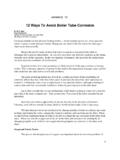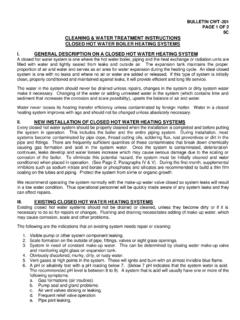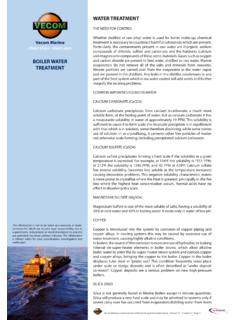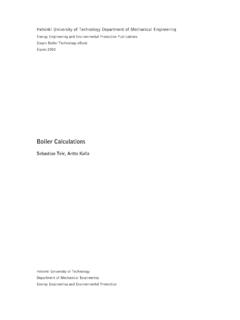Transcription of 12 Ways To Avoid Boiler Tube Corrosion - BOILERSMITH
1 APPENDIX "D". 12 Ways To Avoid Boiler Tube Corrosion By: H. F. Hinst Plant Metallurgist Tubular Products Division, Keystone Plant The Babcock & Wilcox Company Corrosion troubles in low pressure heating boilers -- which usually operate at a steam pressure below 15 psig or water pressures below 30 psig and are often of the horizontal fire tube type -- often occur unnecessarily. During the past 60 years we have had many occasions to examine Boiler tubes to determine the reason for their failure. In very few cases have any defective qualities in the tubing been the cause of the Corrosion .
2 In the vast majority of instances, the necessity for replacement has been traced to conditions of environment. In power boilers, it is a rare occurrence to find Corrosion of the type common to heating boilers. This is because operators of power boilers realize the importance of proper water and fire side conditions and take care to Avoid such problems. The users of heating boilers are, first of all, usually not aware of the possibilities of Corrosion . Often they have little idea what causes it and lack the know-how and experience to combat it.
3 Fortunately, scale is not a major factor in low pressure boilers, although a buildup of scale at tube ends has occasionally resulted in failure by grooving next to the tube sheet. Let us first consider the various mechanisms which lead to pitting or water side Corrosion since this is the most common type. This accounts for 75 percent of the tubes examined in our laboratory. Steel does not corrode appreciably in dry air, but only in the presence of moisture. Likewise, steel will not corrode in clean, alkaline, freshly-boiled water , if air is kept away.
4 This has been proven to our satisfaction by placing samples of tubes in ordinary tap water in flasks and boiling the water , causing the steam to condense and run back into the flask. When we allowed the condensed drops of water to be free to contact the air, Corrosion of the tubes took place. When we took the oxygen out of the air in the flask and condenser by running the air through pyrogallic acid (which is an oxygen-absorbing liquid), no Corrosion of the tubes took place. Oxygen and Velocity Factors This proves that the presence of oxygen is an important factor in Corrosion problems.
5 It 1. APPENDIX "D". was also found that if the heaters were shut down at night, the Corrosion was much more rapid than if the apparatus were kept boiling. In effect, some of the oxygen was excluded from the flask by the steam space over the boiling water . In low pressure heating boilers, however, the return water usually enters at the bottom, which does not afford the oxygen reduction which would be obtained if it would drop through the steam space. Pitting is probably the most destructive form of Corrosion that affects the water side of Boiler tubes .
6 Frequently, only a few pits are present and most of the surface is unattacked. In other cases, the pits cover most of the surface, and as a further extreme, the pits all run together and the Corrosion takes the form of uniform attack. The frequency of the pits is determined to a large extent by the degree of acidity or alkalinity of the water . Acidity and alkalinity are dependent upon the amount of hydrogen-ion concentration found in the water . Both would be expressed in terms of the pH scale. A strong acid solution -- strong muriatic or sulfuric acid -- is rated as 1; a strong alkaline solution -- concentrated caustic soda -- is rated as 14.
7 A neutral water has a pH value of 7. Below a pH of 5, the water is actually sufficiently acid to dissolve the steel, and under these conditions no pits form. Instead, the Corrosion is relatively uniform and the steel gradually gets thinner until it is too weak to hold the pressure, or a small hole develops. Between a pH 5 and , pitting takes place at a rate depending on the concentration of oxygen in the water . Therefore, while operating the Boiler , it is necessary that all air or as much air as possible be excluded from the Boiler water .
8 It has been shown that a strip of steel hung in the middle of a fast moving stream did not rust, while an identical piece hung in a stagnant pool along the edge of the same stream pitted badly when connected to the first by a wire. This proves that velocity and air content have an effect on the Corrosion of steel. In most cases, the pitting in horizontal fire tube boilers takes place along the top of the tubes on the outside, and it is our belief that this may in part be due to the difference in velocity of the rising water and steam bubbles, creating an eddy effect along the top of the tube and accelerating the Corrosion , much as did the experiment of the flowing stream.
9 In any event, pitting would not occur in this type of Boiler if no oxygen were present in the water . Practically all ground surface supplies of water contain dissolved air in quantities depending on its source, time of exposure and its temperature. Cold water will retain more air than warm water , as can be seen by filling a clear bottle with cold water from a tap and allowing it to stand overnight. Small air bubbles will form on the sides, demonstrating that as the water warms up the gas is liberated. This release of the air in the form of bubbles creates a problem in a newly filled Boiler .
10 In 2. APPENDIX "D". a new Boiler , or in one which has been drained and refilled with cold water , as the water warms up, air bubbles form on the tubes . In a very short time pits develop under these bubbles, due to the difference in oxygen concentration under the bubbles and the oxygen concentration in the water surrounding the bubbles. Penetration as high as 50 percent of the tube wall has been known to take place in one stagnant period of two weeks duration. Once these pits form, they proceed rapidly even under operating conditions.








